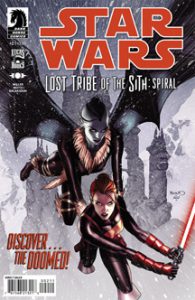During the Expanded Universe era, the Bantam/Del Rey books and Dark Horse comics didn’t collaborate too often, but when they did, it was often a treat. A prime example is John Jackson Miller’s “Lost Tribe of the Sith: Spiral” (2012). It spins off from “Lost Tribe of the Sith: The Collected Stories,” nine novellas that give us the multi-millennial backstory of the sheltered Sith culture that finally springs itself on the galaxy in “Fate of the Jedi.”
Miller’s storytelling (as we already knew from “Knights of the Old Republic” and “Knight Errant”) works just as well in comics as in prose, but as a bonus, we also see the planet Kesh and its denizens – blue-skinned Keshiri, plus humans, plus a multi-species group called The Doomed – brought to life. The Japanese-influenced architectural designs fit with what I imagined from the novellas.
Jackson is a master at making grand civilizations spring to life, while also keeping things personal, and “Spiral” is a prime example. The five-issue series – ideally read in one or two sittings — does ask a reader to pay close attention, because in order to make a planet’s history vibrant, Miller makes it complex. Some of the Keshiri serve in the lord’s court, and some of the humans are slaves, as the illustrations help us understand. He also answers some lingering questions from “The Collected Stories,” which is ideally read before “Spiral.” Here, we learn why the Keshiri weren’t surprised by the arrival of the Lost Tribe of the Sith: Millennia before the Lost Tribe came, a war between dark and light Jedi spilled onto the planet, thus leading to the natives’ lore about how their overlords would return.
The Lost Tribe’s exploration of Kesh parallels Europeans’ exploration of the Earth. In “Pandemonium,” the last entry in “The Collected Stories,” we journey from the “home continent” of Keshtah to the continent Alanciar, a parallel to the New World. “Spiral’s” protagonists – the lord’s daughter Takara Hilts and the slave Parlan Spinner – are supposedly headed to Alanciar as exiles, trading barbs all the way. Takara has access to power but doesn’t crave it; Spinner craves power but doesn’t have access to it. (Although both are dark-side users, everyone on this planet is, so the duo still works as protagonists worth rooting for, if not precisely “heroes.”)
However, Miller throws a curveball: The ship is actually headed to Eshkrene, a heretofore unknown continent akin to Antarctica, where Takara and Spinner meet yet another isolated group. The Doomed took it upon themselves to make sure forces from that ancient Force war would never rise again, by guarding a dark-side weapon that was left behind.
In a nice call-back to Marvel’s Annual No. 1 (“The Long Hunt”), The Doomed’s leader is Kaliska, a member of the S’kytri species. A well-designed humanoid species, with wings that allow for flying, they should’ve appeared in more Legends stories. It’s amusing to see Kaliska carry Takara around like the flying X-Men transport their non-flying brethren.

Although it’s a nice tie-in that the mysterious weapon – a hibernating Sith Lord named Dreypa – comes from the era of “Knights of the Old Republic,” I have to admit that Dreypa himself is a bit of a clichéd powermonger. It’s hard not to see him as somewhat of a parody, especially since I often detect a smirk behind Miller’s words. (For example, in “Spiral’s” introduction from a Keshiri perspective, he writes: “… they are the Lost Tribe of the Sith, and they are all that is great in the universe! We know, because they told us so!”) I somewhat forgive the cliché because Dreypa’s power-grab serves a backdrop for the interplay between Spinner and Takara, which is at the heart of “Spiral.”
Although a lot of Dark Horse titles from the early 2010s were cut short by the Disney purchase (including Miller’s “Knight Errant”), it seems like “Spiral” was intended to be the author’s last word in his “Lost Tribe” saga. The final panel suggests that Spinner and Takara – now both serving the tribal lord — are hitting it off, with captions noting that “hands come in twos,” and “the Sith await their revenge …”
This might be a veiled reference to the Rule of Two, which developed much later in the “Darth Bane” books — off the planet Kesh, of course, although perhaps the Lost Tribe came up with the same ideal on their own. The Lost Tribe’s desire for revenge on the galaxy would then be picked up in “Fate of the Jedi” through characters such as Vestara Khai, who becomes Ben Skywalker’s girlfriend. The arc of that relationship, unfortunately, gets cut short, but at least Miller completed his Lost Tribe backstory before the dark times arrived.

